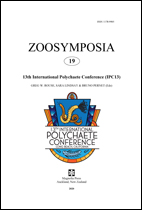Abstract
The morphology of an early nectochaete larva belonging to Chrysopetalum sp. is aligned with that of a planktotrophic larva at a crucial stage of benthic settlement: an entire provisional spinose notochaetal scleritome, large episphere with prostomial nascent sensory structures and larval podia and cirri of the anterior two segments in transition. Morphological sequences of post-larvae and juveniles, common to a number of Chrysopetalum species, indicate that long, slender, provisional, camerate notochaetal spines are replaced during metamorphosis and growth with an entire adult, camerate notochaetal scleritome consisting of broad paleae with internal, longitudinal ribs. The Chrysopetalum sp. six segment larva supports achaetous notopodia I and chaetous notopodia II, each with a pair of dorsal cirri, ie. 4 cirri in total; segment II has acirrose neuropodia. Individuals of post-larvae and juvenile Chrysopetalum species, 8–15 segments, possess a total of 6 cirri on segments I and II: segment I with a pair of tentacular dorsal cirri and the formation of a pair of tentacular ventral cirri, and segment II comprising a pair of dorsal cirri, spinous notochaetae and acirrose neuropodia. During metamorphosis the acirrous neuropodia of segment II are reabsorbed and replaced in stages with a pair of ventral tentacular cirri until the adult state is achieved: achaetous segment 1 with two pairs of tentacular cirri and segment II similar, ie. total of 8 cirri. The cirri arrangement of segments I and II before final metamorphosis in post-larval stages of Chrysopetalum species is, interestingly, that described for adults in the majority of other Chrysopetalinae taxa. Ontogenetic developmental processes of formation and loss of acirrose neuropodia and replacement of spinose larval notochaetae with adult paleae observed in Chrysopetalum species are compared with species of other taxa of the Chrysopetalinae.
References
Aguado, M.T., Capa, M. & San Martin, G. (2003) The genus Chrysopetalum Ehlers, 1864 (Annelida: Polychaeta: Chrysopetalidae) in the Pacific Coast of Panama. Biological Proceedings of Washington, 116 (1), 82–95.
Blake, J.A. (1975) The larval development of Polychaeta from northern California coast. 111. Eighteen species of Errantia. Ophelia, 14, 23–84.
https://doi.org/10.1080/00785236.1975.10421969
Cazaux, C. (1968) Etude morphologique du dévelopment larvaire d’Annélides Polychètes (Bassin d’Arcachon) 1. Aphroditidae, Chrysopetalidae. Archives de Zoologie Experimentale et Génerale, 109, 477–543.
Dahlgren, T.G. & Pleijel, F. (1995) On the generic allocation Chrysopetalum caecum Langerhans, 1880 (Polychaeta, Chrysopetalidae). Mitteilungen Hamburgisches Zoologisches Museum und Institut, 92, 159–173.
Ehlers, E. (1864) Die Borstenwürmer (Annelida Chaetopoda) nach systematischen und anatomischen Untersuchungen dargestellt. Whilhelm Engelmann, Leipzig, pp. 1–268.
https://doi.org/10.5962/bhl.title.2081
Gravier, M.C. (1901) Contribution á l’étude des Annélids Polychètes de la Mer Rouge. Nouvelles Archives de Museum Paris, Ser. 4. 3,147–268, pls.7–10.
Grube, E. (1855) Beschreibungen neuer oder wenig bekannter Anneliden. Archiv für Naturgeschichte, Berlin, 21, 81–136.
https://doi.org/10.5962/bhl.part.13989
Johnson, H.D. (1897) Pacific Coast Annelids. California Academy of Sciences, 1, 163–164.
Katzmann, L., Laubier, L. & J. Ramos (1974) Une nouvelle espéce Mediterranéene de Chrysopetalidae (Annélides Polychètes). Annalen des Naturhistorischen Museums in Wien, 78, 311–317.
Perkins, T.H. (1985) Chrysopetalum, Bhawania and two new genera of Chrysopetalidae (Polychaeta), principally from Florida. Proceedings Biological Society of Washington, 98, 856−915.
Rouse, G. & Pleijel, F. (2001) Polychaetes. Oxford University Press Inc., New York.
San Martin, G. (1986) Acanthopale perkinsi gen.et sp.n. (Polychaeta, Chrysopetalidae) from Cuba and Florida. Zoologica Scripta, 15 (4), 305–312.
https://doi.org/10.1111/j.1463-6409.1986.tb00231.x
Tilic, E., Sermelwall, S. & Bartolomaeus, T. (2018) Formation and structure of paleae and chaetal arrangement in Chrysopetalidae (Annelida). Zoomorphology, 138 (2), 209–220 .
https://doi.org/10.1007/s00435-019-00435-7
Watson, C. (2001) New genus and species of Chrysopetalidae (Polychaeta) from hydrothermal vents (south-western Pacific). Beagle, Records Museum & Art Gallery of the Northern Territory, 17, 57–66
Watson, C. (2010) Revision of the pantropical genus Treptopale (Annelida: Phyllodocida: Chrysopetalidae): redescription of Treptopale rudolphi Perkins, 1985 and description of two new species including comparison of Treptopale populations in northern Australia. The Beagle, Records of the Museums and Art Galleries of the Northern Territory, 26, 37–55.
Watson, C. (2015) Seven new species of Paleanotus (Annelida: Chrysopetalidae) described from Lizard Island, Great Barrier Reef, and coral reefs of northern Australia and Indo-Pacific: two cryptic species pairs revealed between western Pacific Ocean and the eastern Indian Ocean. Zootaxa, 4019 (1), 707–732.
https://doi.org/10.11646/zootaxa.4019.1.24
Watson, C. (2020 in press) Chrysopetalidae Ehlers, 1864. In: Schmidt-Rhaesa, A. (Ed.), Zoology Online. De Gruyter, Berlin.
Watson, C., Chivers, A., Narayanaswarmy, B.E., Lamont, P.A. & R. Turnewitsch (2014) Chrysopetalidae (Annelida: Phyllodocida) from the Senghor Seamount, NE Atlantic: taxa with deep-sea affinities and morphological adaptations. Memoirs Victorian Museum, 71, 311−325.
https://doi.org/10.24199/j.mmv.2014.71.24
Watson, C. & Faulwetter, S. (2017) Stylet jaws of Chrysopetalidae (Annelida). Journal of Natural History 51 (47–48), 2863–2924.
https://doi.org/10.1080/00222933.2017.1395919
Watson, C., Tilic, E. & Rouse, G.W. (2019) Revision of Hyalopale (Chrysopetalidae: Phyllodocida; Annelida): an amphi-Atlantic Hyalopale bispinosa species complex and five new species from reefs of the Caribbean Sea and Indo-Pacific Oceans. Zootaxa, 4671 (3), 339–368.
https://doi.org/10.11646/zootaxa.4671.3.2
Watson Russell, C. (1986) (= C. Watson) Paleaequor, a new genus of polychaete worm (Chrysopetalidae). Records Australian Museum, 38, 153−174.
https://doi.org/10.3853/j.0067-1975.38.1986.180
Watson Russell, C. (1987) Chrysopetalidae. Description and identification of polychaete larvae: their implications in current biological problems. Oceanis, 13, 660–670.
Watson Russell, C. (1991) Strepternos didymopyton Watson Russell in Bhaud and Cazaux, 1987 (Polychaeta: Chrysopetalidae) from experimental wooden panels in deep waters of the western North Atlantic. Ophelia, Suppl. 5, 283–294.
Watson Russell, C. (1997) Patterns of growth and setal development in the deep-sea worm, Strepternos didymopyton (Polychaeta: Chrysopetalidae). Bulletin Marine Science, 60, 405–426.
Watson Russell, C. (1998) Description of Arichlidon new genus and two new species from Australia; Bhawania reyssi redescribed and assigned to Arichlidon (Chrysopetalidae: Polychaeta) Beagle, Records of the Museum & Art Gallery of the Northern Territory, 14, 159–176.
Watson Russell, C. (2000a) Family Chrysopetalidae. In: Beasley P.L., Ross, G.B. & Glasby, C.J. (Eds.) Polychaetes and allies: the southern synthesis. CSIRO Publishing, pp. 121−125.
Watson Russell, C. (2000b) Description of a new species of Arichlidon (Chrysopetalidae: Polychaeta) from the West Atlantic and comparison with East Atlantic species Bulletin Marine Science, 67, 465–477.


